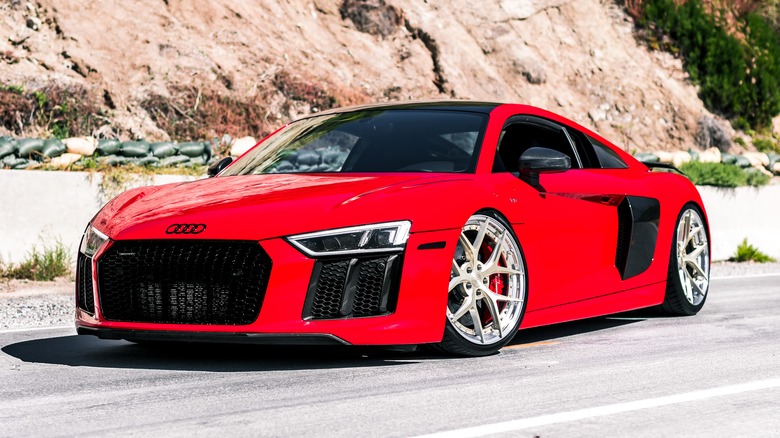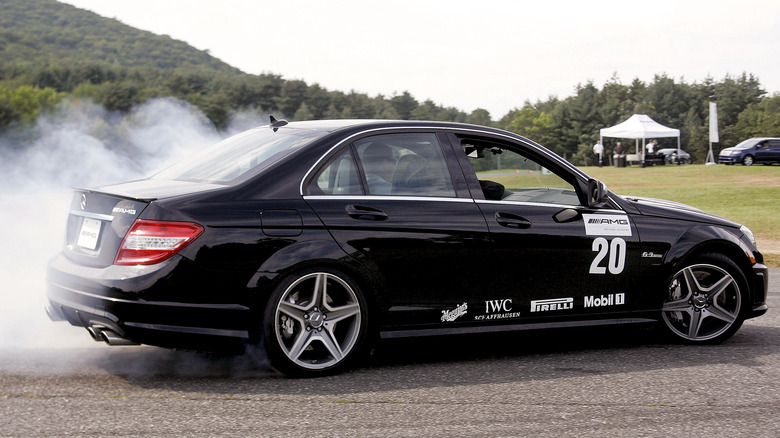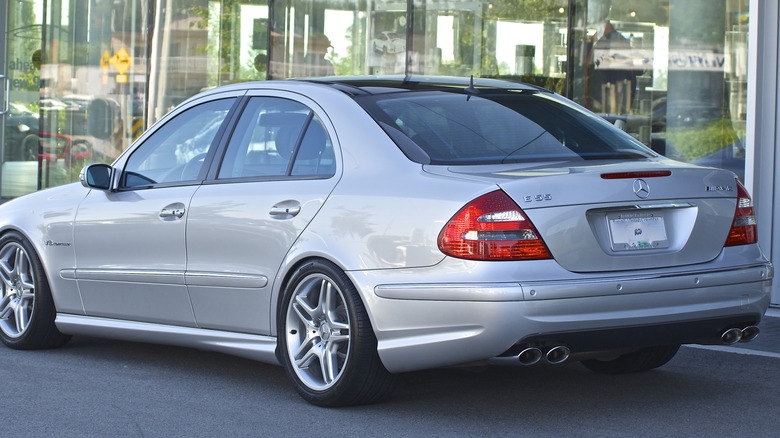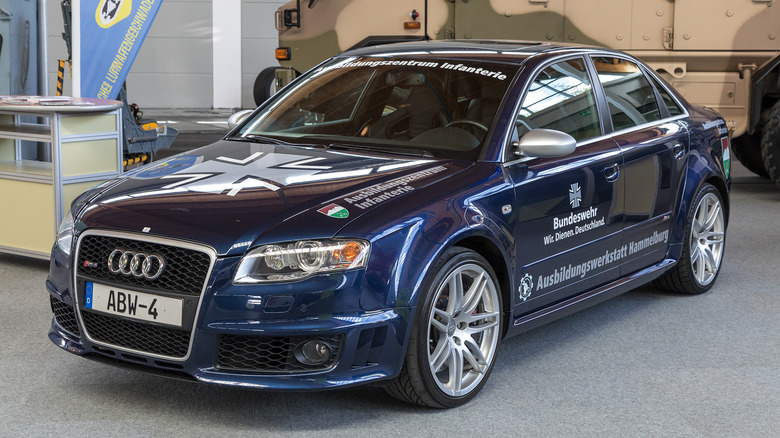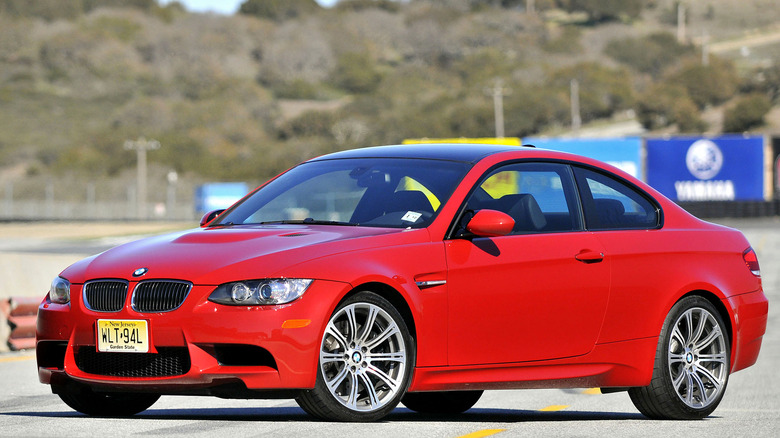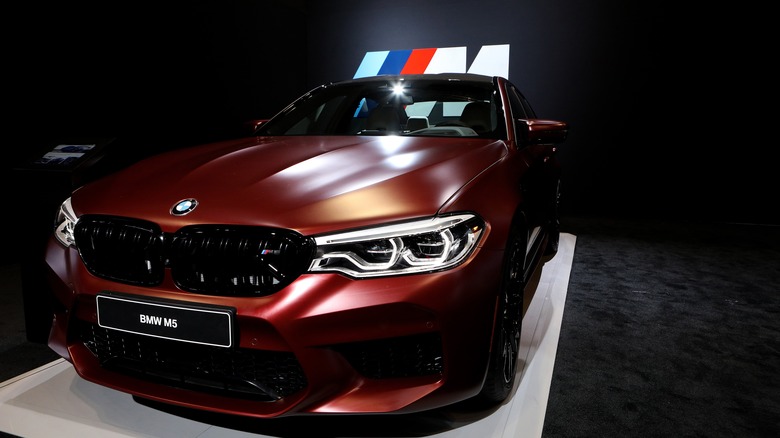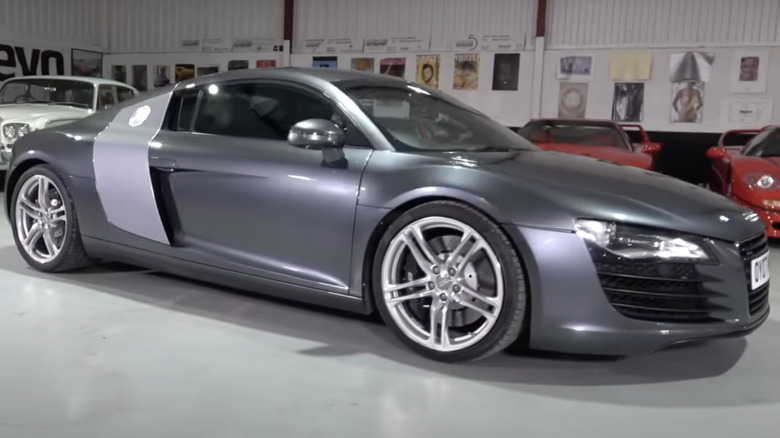6 Of The Coolest German Muscle Cars Ever Built
When most of us hear the term "muscle car," we think of good old American bone-shaking behemoths like the Oldsmobile 442, Pontiac GTO, and Chevy Corvette. Even when the conversation shifts to lesser-known representatives from the genre, we tend to recall underappreciated models from the likes of American Motors or other stateside manufacturers before considering German models, which have a more refined reputation.
That's doing our friends from the Rhineland short shrift, however. German engineering has produced plenty of cars that are just as capable of pinning drivers and passengers against their seatbacks as any Mustang, Roadrunner, or Cutlass. Many of Germany's fastest production cars sprouted from a racing pedigree: Audi has a long history of success in rally racing with the Quattro, and Mercedes dominated Formula 1 for most of the 2010s.
The cars on this list from German manufacturers like Mercedes-Benz, Audi, and BMW are like their American muscle car counterparts in that they have a high power-to-weight ratio, potent V8 engines, and the ability to pump adrenaline into the blood vessels of their drivers when their right foot goes to the floor.
Mercedes-Benz C63 AMG
Mercedes' partnership with AMG has produced some memorable and powerful machines, but perhaps the most impressive is the C63 AMG version of the W204 C-class sedan that Mercedes began building in 2008. It had a 6.2-liter V8 that made 451 horsepower and 443 pound-feet of torque, and could go from 0-60 in 3.9 seconds and hit a top speed of 155 mph.
This car wasn't all brute power, however. The vented disc brakes could bring the C63 AMG to a stop from 60 mph in just 114 feet. Motor Week noted, "The steering is razor sharp, and chassis balance is practically perfect ... Noise and vibration are well controlled, while still allowing you to savor the V8 engine's glorious growl."
Jeremy Clarkson of Top Gear took it for a white-knuckle test drive and concluded, "It's not a car, it's a complete animal." He was at times frustrated by the C63's too-active traction control, but admitted that he found the car a bit hard to control when the system was deactivated. "You don't really drive this car, you cling on for dear life."
Mercedes-Benz E55 AMG
AMG was founded by engineers Hans Werner Aufrecht and Erhard Melcher in the 1960s and partnered with Mercedes on potent V8s like the one that powered the mid-'80s W124 E-class sedan that became known as "The Hammer." As the 20th century drew to a close, AMG turned its focus to the limited edition E55 sedan. Just over 2000 AMG E55s were produced over four years beginning in 1998, and they all got AMG's specially crafted 5.5-liter V8.
This engine was the biggest ever put in a Mercedes car to that point, and produced 349 horsepower and 391 pound-feet of torque. The E55 AMG could go wheel-to-wheel with the fastest cars of the era, clocking a 0-60 time of 4.8 seconds. That was just 0.2 seconds slower than the 427 Shelby Cobra and Ferrari F355 F1 and almost a half second quicker than the Jaguar XJR. Motor Trend's Jeff Karr was blown away by the E55 AMG's power and refined manners, calling it "the greatest sport sedan ever to ride the face of the earth."
[Featured Image by Rich7333 via Wikimedia Commons | Cropped and scaled | CC BY-SA 4.0]
Audi B7 RS4
Audi's first V8-powered car was the V8 sedan it introduced in 1988, and despite the V8's modest market impact, Audi persisted in developing eight-cylinder engines. The RS4 Avant was introduced for the 2000 model year with a 380 horsepower 2.7-liter V6, but when Audi updated the RS4 in 2006 it upgraded the powerplant to a 4.2-liter V8 that generated 414 horsepower and 317 pound-feet of torque.
That engine could get the 3,600 pound RS4 from 0-60 in 4.3 seconds. Georg Kacher of Motor Trend found the RS4's all-wheel drive system and six-speed manual transmission a joy to operate, although he criticized the car's harsh ride and uncomfortable driving position. Overall, he was pleased with the RS4, particularly the 4.2-liter V8. "In more ways than one, the new RS4 is a move in the right direction. The brawny, normally aspirated engine is much more involving than the turbos; the brakes, grip, traction, and roadholding are simply sensational; and the recalibrated Quattro hardware removes several layers of indifference from the steering and the drivetrain."
[Featured Image by Matti Blume via Wikimedia Commons | Cropped and scaled | CC BY-SA 4.0]
BMW E92 M3
North American buyers were first gifted the BMW M3 for the 1988 model year, but the sport-oriented version of the 3 series didn't get a V8 engine until the E92 debuted in 2008. The E92 M3 was replaced by the F82 M4 in 2014, and with the new badge, BMW went back to an I6 powerplant. The short run wasn't the only special thing about the E92, though.
BMW redesigned many of the M3's components to cut weight, replacing the steel roof with a carbon fiber one and saving 15 pounds with a new rear seat pass-through to the trunk. With all that weight savings, the 4.0-liter, 414 horsepower V8 could get the E92 from 0-60 in just 4.4 seconds. After his test drive, Car and Driver's Mike Austin praised BMW for producing a well-balanced car that was at once beastly and tame. "Fast corners, slow corners, accelerating, or braking, it's just sensational," he wrote. "There's a playful, forgiving nature to the M3 that belies its extreme abilities in the same way that a tiger cub can be cuddly-cute one moment and ferocious the next."
BMW F90 M5
In terms of pure power, it's hard to top the F90 series BMW M5. The F90 came to market for the 2018 model year, with a 4.4-liter twin-turbo V8 that put out a staggering 591 horsepower and 553 pound-feet of torque. With that power output, the F90 M5 was truly racetrack-worthy, capable of going from 0-60 in 3.2 seconds and reaching a top speed of 190 mph.
The F90 was the first M5 to come with all-wheel drive, but it also allowed the driver to shift all the power to the rear wheels via a dashboard button or selection on the iDrive menu. Selectable modes were also available for throttle response, stability control, steering, and shift patterns. CNET's Antuan Goodwin found these advanced systems a welcome complement to the M5's unholy power. "When BMW says it builds the 'Ultimate Driving Machine,' it's talking about the M5," he wrote. "The super sedan brings nearly every tech bell and performance whistle in the brand's arsenal to bear in the pursuit of speed. This is a car that doesn't know the meaning of the word 'compromise.'"
Audi R8
Audi built the R8 on the Lamborghini Gallardo chassis and presented it at the 2003 Geneva Motor Show before introducing it as a production model in 2006. Upon its release, endurance racing legend Jacky Ickx called it "the best handling road car today" (via Top Speed). That agility was necessary to corral the potency of the two available V8 engines; a dry sump version of the RS4's 4.2-liter V8 or a 525 horsepower 5.2-liter V10. The V10 version could go from 0-60 in 3.4 seconds and topped out at just under 200 mph.
The R8 stayed in production until the 2023 model year, when Audi sent it off with a special GT edition that came in rear-wheel drive only with a 602 horsepower V10 and a sticker price that ranged from $161,395 to $253,290 depending on options. Car and Driver's Drew Dorian felt that despite the exorbitant price tag, most drivers would be well-suited to the R8. "Few supercars actually get driven daily, but the 2023 Audi R8 seems designed for such a task," he wrote. "The interior is comfortable for both driver and passenger, and the R8 would make a fine touring car if it weren't for a puny cargo area that fits only one carry-on suitcase."
